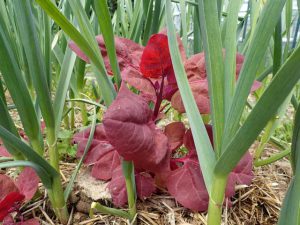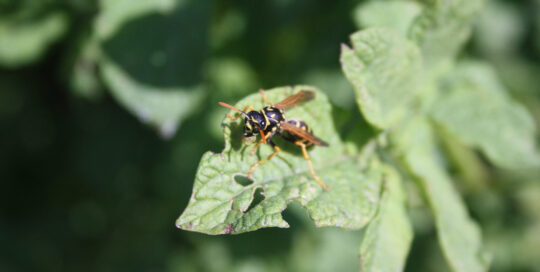Time to Look into Companion Planting
Views: 5169

I’ve never been a big proponent of companion planting, probably because my gardens all seemed to do well without it. Plus it requires too much mental planning to put some plants together and keep others apart. Yet, after noticing an interesting situation in the garden, I believe I need to look into it further.
Orach is a favorite in our garden. The pretty red leaves are terrific braised; I often use them in my eggs in the morning. And reaching 6 feet tall, the orach is an impressive addition to the vegetable beds. Additionally, it’s frequently a blue ribbon winner in the fair. Orach packs a nutritional punch boasting more than twice as much vitamin C as lemons. It touts properties that aid digestion and possibly preventing cancer because of its antioxidant qualities.
Our 7 year old always grows it since he likes entering it in the fair. He transplanted a few of the plants that reseeded on their own from last season. It started off fine, but lately his plants are obviously being eaten by something. My guess is snails. My first thought is to dust it with diatomaceous earth, yet with all of the rain we’ve had, it would simply wash away.
Benefits of companion planting
When I was working in the garden today, I happened to glance at the orach growing in the garlic patch. They were huge and perfect. No holes in the leaves and they were growing vigorously. That really caught my attention. I wonder if either being near the garlic naturally repels the insects, or whether it’s from being tucked in among the taller plants. Either way, it’s working.
Although I can’t say I understand the idiosyncrasies of companion planting, I think I need to study it. From what I do grasp, part of the pest control situation is either by chemicals released by the neighboring plants. For instance, the garlic is a well-known repellent so it’s not very surprising that it will impart those qualities to the orach interspersed within the bed. Another way they help is to provide a trap crop for the pests enticing them to eat one plant while leaving the other, preferably vegetable, crop alone.
Other beneficial qualities involve adding specific nutrients to the soil or growing as such to improve the growing conditions of the nearby plants. One example is the three sister garden where corn, pole beans, and squash are grown together. The beans are supported by the corn, and the squash sprawls out below it all shading the soil and retaining moisture. It works. And certain flowers can be planted near vegetables to bring in pollinators, as well as beneficial insects. One tip I read was to plant alyssum near potatoes or broccoli because the alyssum draws in predatory wasps that feed on the pests.
It’s been an interesting observation to see how well the orach is doing planted among the garlic. It’s definitely time to check out this companion planting deal!
Meet Amy Grisak
Amy is a freelance author and photographer in Great Falls, MT who specializes in gardening, foods, and sustainable agriculture. She provides information on every kind…
Amy's Recent Posts

Looking into the Crystal Ball for a Pest Report








